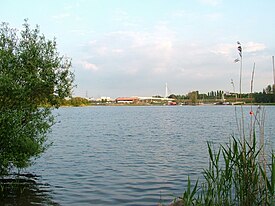Sale Water Park
| Sale Water Park | |
|---|---|

Sale Water Park, from the northeast of the lake
|
|
| Type | Public park |
| Location | Sale, England |
| Coordinates | 53°25′55″N 2°17′56″W / 53.432°N 2.299°WCoordinates: 53°25′55″N 2°17′56″W / 53.432°N 2.299°W |
| Area | 152 acres (62 ha) |
| Created | 1979 |
| Operated by | Trafford Council |
| Status | Open all year |
Sale Water Park is a 152-acre (62 ha) area of countryside and parkland including a 52-acre (21 ha) artificial lake in the Metropolitan Borough of Trafford in Greater Manchester, England. Opened in 1979 and owned by Trafford council, the water park lies in an area of the green belt running through the Mersey river valley between Sale and Stretford, located between the river and the M60 motorway. The lake was formed in the 1970s by the flooding of a gravel pit excavated to provide material for the construction of an embankment raising the motorway 34 feet (10 m) above the Mersey's floodplain. The pit was excavated to a depth of around 115 feet (35 m), making the lake about 90 feet (27 m) deep in places.
The land occupied by the water park was formerly within the grounds of Sale Old Hall, demolished in 1920. All that remains of the hall today is its former lodge, now the club house for Sale Golf Club, and its dovecote, which has been restored and relocated to the nearby Walkden Gardens.
Sale Water Park provides important recreational facilities and wildlife reserves, as well as forming part of the flood defences for the surrounding area of Trafford.
Broad Ees Dole, located in the northeast of Sale Water Park, is an important wildlife refuge. Major work was carried out in the 1980s to develop Broad Ees Dole into a wetland area that could be managed to improve the wildlife value of the park, in particular for wild birds, the main lake being too deep to provide food for many bird species. It was officially opened in 1987.
The amount of water entering and leaving the Dole is managed, maintaining its mud flats to make sure they are available for birds like snipe and little ringed plovers throughout the year. Migratory birds like redshank and sandpipers also use the Dole as a resting and feeding place on their route north for the summer. In summer and winter, water is allowed in, to prevent the mud from drying up; in spring and autumn, water is released, to expose the mud.
...
Wikipedia
